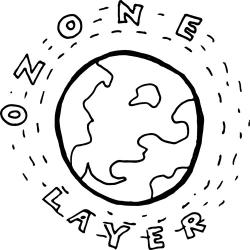Source Institutions
Add to list Go to activity
Activity link broken? See if it's at the internet archive

Working in groups, learners model the continuous destruction and creation of ozone (O3) molecules, which occur in the ozone layer. Some learners act as ultraviolet (UV) light and break apart gumdrop and toothpick models of ozone molecules into oxygen molecules and atoms. Meanwhile, other learners assemble ozone molecules from the oxygen molecules and atoms. In a second round, learners model the situation when pollutants such as chlorofluorocarbons (CFCs) are present. In subsequent rounds, the amount of CFCs changes according to historical data, and learners can see what happens to the proportion of ozone and oxygen in the ozone layer over time. Resource contains vocabulary definitions and suggestions for assessment, extensions, and scaling for different levels of learners.
- 10 to 30 minutes
- 45 to 60 minutes
- $1 - $5 per group of students
- Ages 8 - 14
- Activity, Demonstration, Model
- English
Quick Guide
Materials List (per group of students)
- 175 round toothpicks (need ~150, but require extras in case of breakage; round toothpicks are stronger than the flat type)
- 300 gumdrops
- 1 roll of masking tape
- Graph paper
- Graph of Global CFC Production, 1952-2000
- Battling for Oxygen Worksheet
- 1 roll of large butcher paper (optional)
- Marking pens (optional)
- Tape (optional)
Subjects
-
Earth and Space Science
-
Earth Processes
- Weather and Climate
-
Earth Structure
- Atmosphere
-
Earth Processes
-
Engineering and Technology
-
Engineering
- Civil Engineering
- Environmental Engineering
-
Engineering
-
Life Sciences
-
Ecology
- Human Impact
-
Ecology
-
Physical Sciences
-
Chemistry
- Chemical Bonding
-
Structure and Properties of Matter
- Atomic Structure
-
Chemistry
-
The Nature of Science
-
Science and Society
- Public Policy
-
Science and Society
Audience
To use this activity, learners need to:
- see
- touch
Learning styles supported:
- Involves teamwork and communication skills
- Involves hands-on or lab activities
Other
Includes alignment to state and/or national standards:
This resource is part of:
Access Rights:
- Free access
By:
- Kolenbrander, Amy ; Yowell, Janet ; Mach, Natalie ; Schaefer Zarske, Malinda ; Carlson, Denise ; Rutkowski, Tom ; Stephens, Tyman
Source Collection
- TeachEngineering
Rights:
- All rights reserved, Regents of the University of Colorado, 2004
Funding Sources:
- Fund for the Improvement of Postsecondary Education (FIPSE)
- U.S. Department of Education
- National Science Foundation, 0226322
